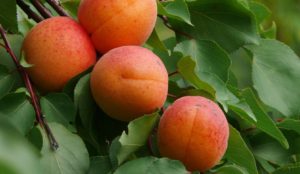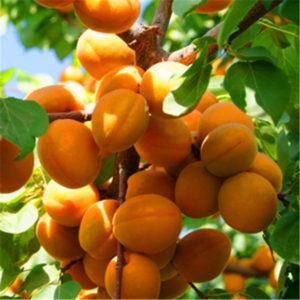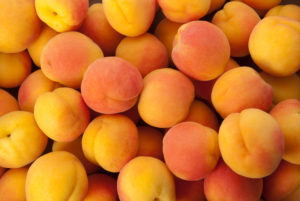Introduction of Apricot: – Apricot is an important fruit grown in the dry temperate and mid-hill regions of India. This fruit belongs to the family of “Rosaceae” and Genus of “Pruns”. The original apricots are native to China where as wild apricot which is known as “Zardalu” is indigenous to India. In India, this fruit grows wild in the hills of Shimla and Himachal Prfadesh. Apricot fruits contain high in vitamin ‘A’ and niacin when compared to other fruits. Apricots are being used for desserts, jam, nectar, squash and these fruits can be dried and canned. Apricot fruit kernels (sweet) are used in confectionery and in oil extraction (bitter kernels). The commercial apricot farming in India is very limited.
Health Benefits of Apricot Fruit: – He following is the health benefits of the Apricot Fruit.
- Apricot is good for eyes (Due to vitamin “A” and beta-carotene).
- Apricot is a rich source of antioxidants and minerals.
- Apricot contains high fiber content which helps relieving constipation.
- Apricot is heart healthy.
- Apricot is helps in controlling blood pressure.
- Apricot lowers the risk of developing cancer.
- Apricot is good for skin disorders.
- Apricot is for anemia patients.
- Apricot helps in asthma patient.
- Apricot helps in weight loss.
- Apricot is good for done strength.
Apricot Local Names in India: – Jardaloo, Khubani, Khumani (Hindi), Jaldharu Pandu (Telugu), Saara Parppu, Sarkkarai Badami (Tamil), Jardalu (Kannada), Mutta Pazham, Sheema Pazham (Malayalam), Jardaloo (Gujarati), Jardaloo (Marathi).
Major Apricot Production states in India: – Himachal Pradesh, Jammu & Kashmir, Uttar Pradesh and some extent of north eastern hill region.
Varieties of Apricot in India: – The following apricot fruit varieties are cultivated in India.
Himachal Pradesh:
- Dry temperate: Kaisha, Suffaida, Shakarpara and Charmagaz.
- Midhills: Shakarpara, New Castle and Early Shipley.
- High Hills; Suffaida, Nari, Charmagaz, Royal, Kaisha and Nugget.
Uttar Pradesh: Moorpark, Early Shipley, Kaisha, Chaubattia Madhu, Chaubattiakesri, Chaubattia Alankar, Charmgaz, Turkey, Bebeco and Ambroise.
 Jammu & Kahmir:
Jammu & Kahmir:
- Kashmir: Shakarapara, Turkey, Rogan, Australian and Charmagaz.
- Ladak: Narmu, Khante, Rakchakarpa, Margulam, Halman and Tokpopa.
Promising varieties for Midhills:
- Early maturing: Beladi and Baiti.
- Late Maturing: Alfred and Farmingdale.
Climate Requirement for apricot farming: – Apricots with white flesh and sweet kernel requires cooler climatic conditions and are best grown in dry temperate areas up to 3000 meter above m.s.l (mean sea level). Yellow flesh apricots with bitter kernel requires warm climatic conditions and are best grown 1000 to 1500 meter above m.s.l (mean sea level). Long cool winters with frost free conditions and North Eastern India at lower elevations are best suited for apricot cultivation. These trees require about 100 cm well distributed annual rainfall throughout its growth period.
Soil Requirement for Apricot farming: – Apricot can be grown on wide variety of soils. However, well drained deep soils with good organic matter are best for its growth and yield. It is recommended to have the soil ph of 6.0 to 6.8. However, wild apricots can be grown in well drained sandy soils with less fertility in Ladakh and Kinnaur region.
Propagation and Raising root stock in Apricot farming: – Generally, apricots are commercially propagated by grafting or budding and T-budding, Tongue grafting and Chip budding are used for its multiplication. For raising rootstock, seeds should be collected from ripen wild apricots. These seeds need stratification for duration of 45 days at 4ᵒ C to break dormancy. After stratification, seeds need to be soaked in 5ppm Kinetin or 500ppm GA3 solution for a period of 24 hours before sowing for speed up the germination. There after seeds should be sown 5 to 10 cm deep on nursery beds at a seed to seed spacing of 15 to 20 cm and row to row distance of 25 to 30cm. After sowing, nursery beds should be mulched and light irrigation should be given. The seedlings will be ready with graft able size in one year after sowing. The seedlings of pencil thickness should be grafted with tongue method.
Land Preparation, Spacing and Planting in Apricot farming: – Dig the pits size of 1 X 1 X1 meter just 1 month before of planting. Each pit should be filled with a mixture of soil and 60 kg of well rotten farm yard manure (FMY), 1 kg of single super phosphate and 10 ml of Choraplyripos solution (10 ml/10 liters of water). As usual, on slope lands, contour planting system and on flat lands, square or triangular planting methods should be followed. The plant spacing depends on the variety soil. The apricot plants are generally spaced at 6m X 6 meter. Transplant the nursery rose 1 year seedlings to the main field place them in the center of the pit. To conserve the soil moisture and check the weeds at basins, mulch the plant basins with the 10 to 15 cm thickness of hay. Make sure to irrigation the plants immediately after planting in the pits of main field.
Intercropping in Apricot Farming: – Intercropping not only results in extra income but also it enriches the soil fertility. The recommended intercrops in apricot farming are soybean, cowpea, beans and pea.
Training and pruning in Apricot farming: – Apricot trees trained on modified centre leader and open vase systems. At the time of plantation, 1 year old whip should be headed back at 70 cm above the ground and 4 to 5 well spaced shoots should be allowed to grow in all directions. To give the good hope, pruning should be carried out in first dormant season. In first dormant pruning, 4 to 5 primary scaffold branches arising at proper angles, well spaced and spirally arranged around the tree trunk should be selected. The slowest branch should be 45 cm above the ground level. During 2nd dormant pruning 6 to 7 well spaced secondary scaffold branches should be selected on each primary branch of the tree and others should be removed. At the end of 3rd year, pruning should be confined to thinning of the branches which are crossing each other or overcrowding.
Irrigation in Apricot farming: – Apricots require irrigation especially during fruit development stage in the month of April to May. Frequency of irrigation depends on the soil type, tree age and weather conditions. During extreme hot and dry periods, irrigations should be given at 8 to 10 days intervals (May to June). In case of heavy rains, soil should be drained out as these are sensitive to water logging.
Mulching in Apricot Farming: – Mulch the apricot tree basins with 10cm thick of hay to conserve the soil moisture and check the weed growth.
Weed control in Apricot farming: – In apricot farming, pre emergence application of Atrazine or Diuron @ 800 ml/hectare or Gramaxone @ 2 liters/hectare is more effective to control the weeds. Mulching also checks out the weed growth.
Manures and Fertilizers in Apricot Farming: – In Apricot farming, both organic manures and chemical fertilizers are required for tree growth and good yield. The fertilizer requirement depends on the soil type, tree age and cultural practices.
Under irrigated conditions, for each matured apricot tree (7 years and above), a mixture of 40 to 45 kg well rotten farm yard manure, 500 grams of ‘N’ 250grams of ‘P205’ and 200 grams of ‘K’ is preferred. The FMY (farm yard manure) should be applied along with full dose of ‘P’ and ‘K’ in the month of December to January. As Nitrogen application is concerned, it should be applied 2 split doses. Half dose of ‘N’ should be applied 3 weeks before flowering and remaining half dose after 4 weeks period. Under rain fed conditions, second half dose of ‘N’ should be applied at the onset of monsoon.
Pests and Diseases in Apricot farming: – The following are the common pests and diseases in apricot farming. Armillary root rot, Ectype dieback, Brown rot blossom, Jacket rot, Phytophthora root and crown rot, ripe fruit rot, verticillium wilt, shout hole disease, Powdery Mildew, Bacterial canker, Crown gall, Rust plum pox virus, European earwig. Fruit tree leaf roller, Green fruit worm, Mealy plum aphid, And Peach Twig Borer. For appropriate control measure of these peats and diseases, content nearest horticulture/agriculture department.
Harvesting in Apricot farming: – Apricot fruits are generally matured in first week of May-June end depending upon variety. Apricot trees start bearing fruits from fifth year and attain maximum fruit bearing stage at 8 to 10 years after planting and continue up to 35 years. Manual harvesting should be practiced. For fresh marketing, fruits should be plucked after they change the surface color from green to yellowish. Fully ripen fruits can be harvest for drying, freezing and canning purpose. Extreme care should be taken care after harvesting as these fruits are perishable. As post harvesting practice, fruits are graded based on the size and packed in the wooden boxes. Apricot fruits can be stored at 0ᵒ C for 1 to 2 weeks by maintaining 85 to 95% relative humidity.
Yield in Apricot farming: – Yield depends on the variety grown and farm management practices. In apricot farming yield of 50 to 85 kg/tree or 15-25 tons/hectare can be obtained.
